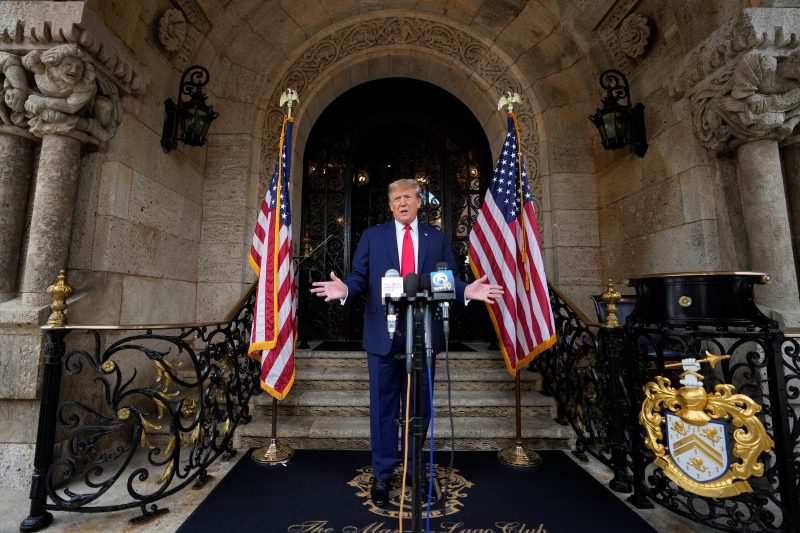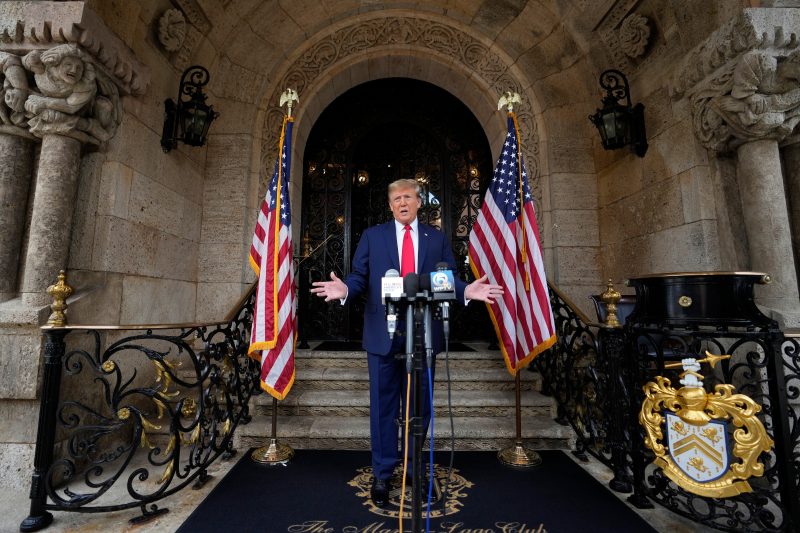
“But if you take a look at my words right after, you take a look at my speech from the Rose Garden, which was very shortly after. … If you take a look at those five or six tweets, you will see very beautiful, very heartwarming statements. ‘Go home, the police are doing their job, etc., etc.’ Beautiful statement. If you see my statement made in the Rose Garden, I think you have to watch that today.”
— Former president Donald Trump, in remarks at his Mar-a-Lago estate, Palm Beach, Fla., Feb. 8
After saying he’d listened to the Supreme Court oral arguments Thursday on whether Colorado and other states can bar him from appearing on the ballot in his bid to return to the White House, Trump reverted to one of his signature falsehoods. The ballot case centers on whether Trump is disqualified from office because he supported an insurrection. Trump, in his Mar-a-Lago remarks, referred to what his detractors “kept saying about what I said right after the insurrection … if it was an insurrection.” He claimed that what he really did was offer “very beautiful, very heartwarming statements” during the Jan. 6, 2021, attack on the Capitol. He also suggested people should view the video he posted late in the day — or as he put it, “very shortly after.”
That would be hard. The video was removed from YouTube and other social media shortly after being posted, on the grounds that it violated the terms of service by spreading false information about the 2020 election.
In reality, as documented in the House select committee report on the Jan. 6 attack and other reporting, Trump was reluctant to take action to calm the situation, even as his staff pleaded with him to tell the rioters to leave the Capitol. Trump’s tweets were so inadequate, in the view of staff members, that many resolved to resign. Even his children Ivanka and Donald Jr. found the tweets to be inappropriate. Nearly three hours passed before Trump finally told the rioters to “go home.”
As a reminder, here’s how the day unfolded. The tweets were removed by Twitter, now known as X, but preserved by the American Presidency Project at the University of California at Santa Barbara, with timestamps to the second.
1:10 p.m.: Trump concludes his remarks to the crowd gathered for the “Save America March” on the National Mall.
1:25 p.m.: Trump is informed by a White House staff member that the Capitol is under attack.
1:49 p.m.: Capitol Police Chief Steven Sund informs the D.C. National Guard “that there was a dire emergency on Capitol Hill and requested the immediate assistance” of as many National Guard troops as possible. The Metropolitan Police Department officially declares a riot.
1:49:54: Trump tweets a link to a recording of his speech at the Ellipse, but without any other comment.
2:13 p.m.: Rioters break into the Capitol and swarm the building.
2:24:22: Trump issues his first written tweet since the attack.
“Mike Pence didn’t have the courage to do what should have been done to protect our Country and our Constitution, giving States a chance to certify a corrected set of facts, not the fraudulent or inaccurate ones which they were asked to previously certify. USA demands the truth!”
According to the committee’s report: “Evidence shows that the 2:24 p.m. tweet immediately precipitated further violence at the Capitol. Immediately after this tweet, the crowds both inside and outside of the Capitol building violently surged forward. Outside the building, within 10 minutes thousands of rioters overran the line on the west side of the Capitol that was being held by the Metropolitan Police Force’s Civil Disturbance Unit, the first time in history of the DC Metro Police that such a security line had ever been broken.”
Deputy national security adviser Matthew Pottinger told the committee that the tweet convinced him to resign that day. “I read it and was quite disturbed by it,” he told the committee. “I was disturbed and worried to see that the President was attacking Vice President Pence for doing his constitutional duty. So the tweet looked to me like the opposite of what we really needed at that moment, which was a de-escalation. …. It looked like fuel being poured on the fire.”
White House counsel Pat Cipollone told the committee: “My reaction to it is that’s a terrible tweet, and I disagreed with the sentiment. And I thought it was wrong.”
The committee report says that Trump’s daughter Ivanka rushed to the Oval Office dining room, where Trump was watching coverage of the riot on Fox News. “Although no one could convince President Trump to call for the violent rioters to leave the Capitol, Ivanka persuaded President Trump that a tweet could be issued to discourage violence against the police,” the report said.
2:38:58: Trump issues a second tweet.
“Please support our Capitol Police and Law Enforcement. They are truly on the side of our Country. Stay peaceful!”
Since the committee’s report was issued, ABC News has reported that special counsel Jack Smith, who is prosecuting Trump for his efforts to overturn the election, has developed evidence that Trump did not write this tweet. Instead it was written by his deputy chief of staff, Dan Scavino, ABC said. (Scavino had refused to be interviewed by the committee, but he spoke to Smith’s team after a judge overruled claims of executive privilege.) Scavino was the only other person who had access to Trump’s Twitter account, and he said he was blindsided by the tweet attacking Pence. Scavino printed out proposed messages to post on Twitter, which Trump refused to approve until Ivanka’s intervention.
The committee’s report said that Trump had even resisted using the word “peaceful.” It quotes Sarah Matthews, who was the deputy White House press secretary, about a conversation she had with Ivanka after Matthews expressed concern the tweet did not go far enough. “In a hushed tone [she] shared with me that the President did not want to include any sort of mention of peace in that tweet and that it took some convincing on their part, those who were in the room,” Matthews told the committee.
In any case, the tweet did not condemn the violence or tell rioters to leave the Capitol.
Around 3 p.m.: White House senior staff worked to produce a message on a notecard for Trump to send: “ANYONE WHO ENTERED THE CAPITOL ILLEGALLY WITHOUT PROPER AUTHORITY SHOULD LEAVE IMMEDIATELY.” (Illegally is crossed out.) Trump declined to make the statement, the committee’s report says.
3:13:26: Trump issues a third tweet.
“I am asking for everyone at the U.S. Capitol to remain peaceful. No violence! Remember, WE are the Party of Law & Order — respect the Law and our great men and women in Blue. Thank you!”
This tweet also did not tell people to go home — and even suggested they could remain in the Capitol, as long as they were peaceful. The report says there is evidence that Trump knew by this time that someone had been shot during the melee.
The committee’s report says that Trump repeatedly resisted telling people to go home. “Almost everyone, including staff in the White House, also found the President’s 2:38 p.m. and 3:13 p.m. tweets to be insufficient because they did not instruct the rioters to leave the Capitol.” It quotes texts to Trump’s chief of staff, Mark Meadows, from outsiders, such as Trump’s son Donald Jr. and Fox News host Sean Hannity, urging a stronger response. “I saw the tweet. Ask people to peacefully leave the capital [sic],” Hannity wrote.
“Evidence showed that neither of these tweets had any appreciable impact on the violent rioters,” the report says.
4:17:24: Trump posts a video that contains many falsehoods about the election, but he finally encourages people to leave the Capitol. The committee’s report says Trump refused to stick to the script written by his staff, so the video included statements such as:
“I know your pain. I know you’re hurt. We had an election that was stolen from us. It was a landslide election, and everyone knows it, especially the other side, but you have to go home now. We have to have peace. We have to have law and order. We have to respect our great people in law and order.”“This was a fraudulent election, but we can’t play into the hands of these people. We have to have peace. So go home. We love you. You’re very special. You’ve seen what happens. You see the way others are treated that are so bad and so evil. I know how you feel. But go home and go home at peace.”
The video has its intended effect — the riot ends — but it came nearly three hours after Trump learned of the attack. The committee’s report suggests Trump issued the video only once it was clear the riot would fail to end the certification of Joe Biden’s election victory.
“Down at the Capitol, the video began streaming onto rioters’ phones, and by all accounts including video footage taken by other rioters, they listened to President Trump’s command,” the report said. “ ‘Donald Trump has asked everybody to go home,’ one rioter shouted as he “deliver[ed] the President’s message.’ ‘That’s our order,’ another rioter responded. Others watching the video responded: ‘He says, go home.’ ”
6:01:04: Trump ends the day with a final tweet that seemed to justify the violence.
“These are the things and events that happen when a sacred landslide election victory is so unceremoniously & viciously stripped away from great patriots who have been badly & unfairly treated for so long. Go home with love & in peace. Remember this day forever!”
White House aides were aghast.
“At that point I had already made the decision to resign and this tweet just further cemented my decision,” Matthews said. “I thought that January 6, 2021, was one of the darkest days in our Nation’s history and President Trump was treating it as a celebratory occasion with that tweet.”
“I thought it was inappropriate,” said Greg Jacob, counsel to vice president Mike Pence. “To my mind, it was a day that should live in infamy.”
(About our rating scale)
Send us facts to check by filling out this form
Sign up for The Fact Checker weekly newsletter
The Fact Checker is a verified signatory to the International Fact-Checking Network code of principles

